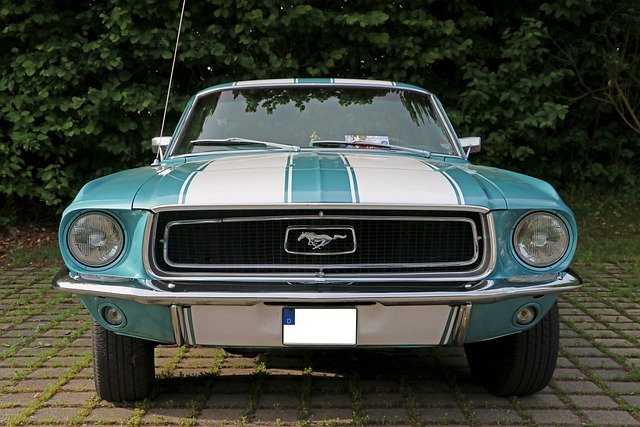The Ford Motor Company Mustang is one of the most recognizable American cars that is not only very well-liked but has also continuously had great sales within the automotive sector.
In April 1964, when the Mustang was initially made available to the general public, I was a little child. I still recall the Ford Motor Company advertising with the horses galloping behind the car. One of my favorite advertising themes at the time was rapidly this one. Every time, I would dash over to the TV to see the ad.

Historically speaking, the genuine Mustang production car was developed using the Mustang I and II concept vehicles. “It is a real pleasure for me to discuss the styling of the Mustang because this vehicle is the result of one of the most exciting and most satisfying design programs of which I have been connected in my 25 years in automotive styling,” stated the late Gene Bordinat, vice president of Design for Ford Motor Company, in April 1964. Those who have seen the plastic models or prototypes of the Mustang have, almost without fail, voiced their desire to own one in addition to praising its looks.
When the Mustang was introduced in the spring of 1964, Ford Motor Company made enormous profits. Over 500,000 models had been sold by the end of the first year. People from all walks of life and all ages found this automobile to be rather popular. Additionally, Mustang was designated as the official Pace Car for the 1964 Indianapolis 500 race. During its mid-year announcement program, Mustang also unveiled the stunning Mustang Fastback GT variant.
Throughout the years, Mustang persisted in providing a wide range of stylish vehicles for the general public. Shelby started building the 350 V-8 engined GT Fastback Mustangs in 1965–1966. These were fast automobiles for those who dared to walk on the wild side and want extreme thrill in their life. Ford and the Mustang had remarkable success in 1967–1968 and again made significant profits in their respective markets. In 1967, Mustang debuted new stylistic elements, and the 2+2 variants added sports car performance and sports stripes.
Shelby Motor Company
Interestingly, Lee Iacocca—the newly appointed vice president of the Ford Division—was also engaged in the Mustang project. Along with many other bright people, the team also featured Donald N. Frey, John Najjar, Joe Oros, Gale L. Halderman, Jimmy Sherbourne, Givliano Zuccato, and Hal Sperlich.
Mustang debuted the Mach I, a special production model with racing stripes, a rear deck spoiler, and an air scoop, in 1969. To satisfy their desire for more, a 428 Cobra engine package was available for purchase. The models brought in $3,125 at auction. Ford’s design direction would later be altered by the Mustang of the 1970s. Ford gave up on most of its worldwide, USAC, NASCAR, and Trans-Am racing endeavors in late 1970. The company also started modifying the Mustang’s personality after what the Ford Division dubbed the “Sizzlin 70s.”
By 1971, a completely new third-generation design had been unveiled. The late Semon E. Bunkie Knudsen, who briefly led Ford Motor Company in the late 1960s, designed this particular model.
1969 Mustang
When Ford Motor Company entered road racing again in 1981, the turbocharged Miller Mustang served as the brand’s cutting-edge flagship vehicle. Under Klaus Ludwig’s leadership, the vehicle swiftly restored Mustang’s winning heritage by winning the IMSA GT races at Brainerd, Minnesota, and Sears Point, California, back-to-back. Ford honored its 25th birthday in 1989 with a high-performance 1989 GT convertible package that many fans appreciated and applauded, marking a significant milestone for the company’s iconic pony cars. With amazing designs that continue to provide a wonderful muscular style for many customers worldwide, Mustang is still going strong today.

Ford’s stellar reputation was established over 50 years of dedication and excellence in performance. Since 1964, a large number of Ford enthusiasts have cherished this American classic. Retaining its distinguished standing, the fashionable 2015 Ford Mustang had its introduction at the site of the world’s fair in New York City, where the legendary pony vehicle made its debut over half a century ago. (Free Press of Detroit).
2010 Mustang
Many thanks to automotive historian and researcher Robert Tate for providing the story for the MotorCities Story of the Week initiative. Photographs are courtesy of Bob Tate’s Collection. (Bibliography: Holls Dave & Lamm Michael. “A Century of Automotive Style 100 Years of American Car Design”.1997. Witzenburg L. Gary. “Mustang: The Whole Story of the Pioneer Ponycar in America.” Workers of the 1979 Automobile Quarterly. “Illustrated History of Ford 1903-1970,” by Dammann H. George (1970)